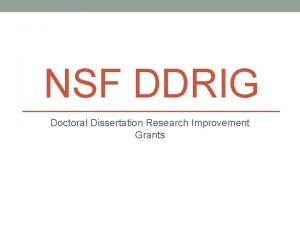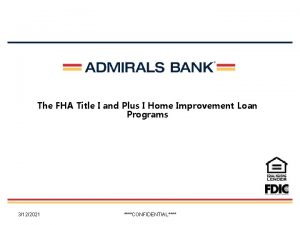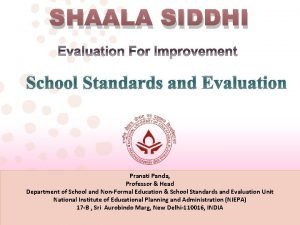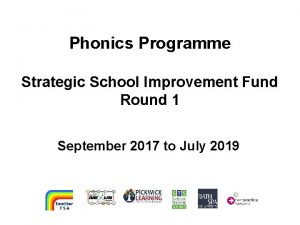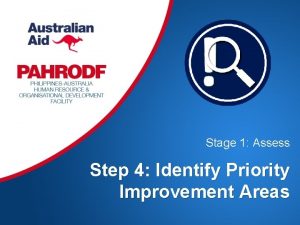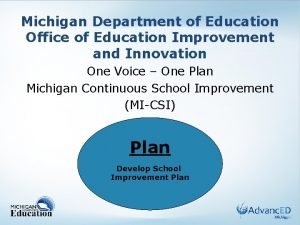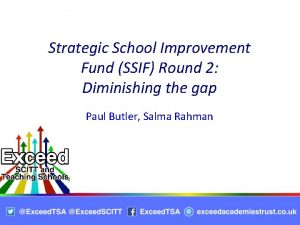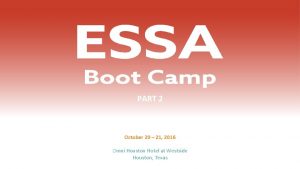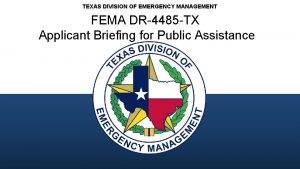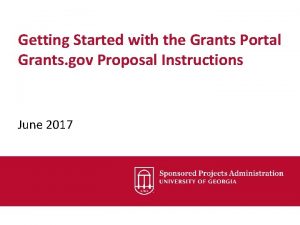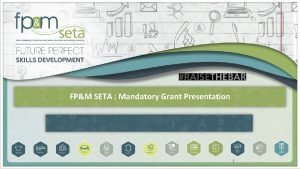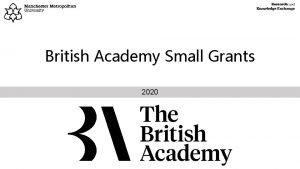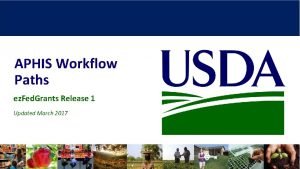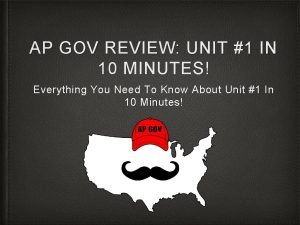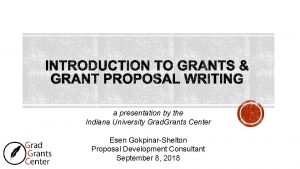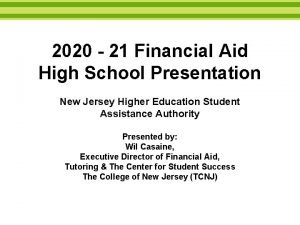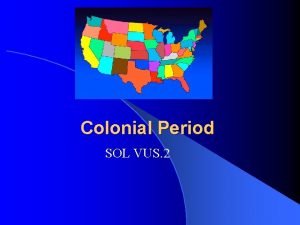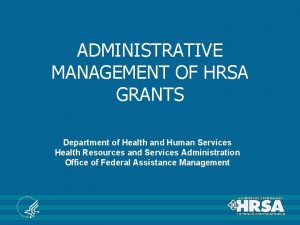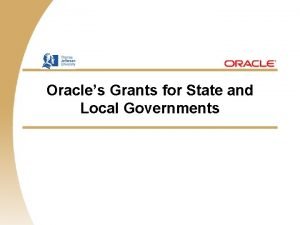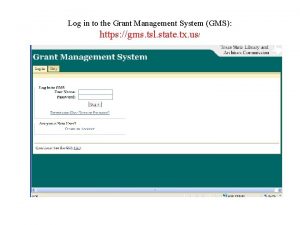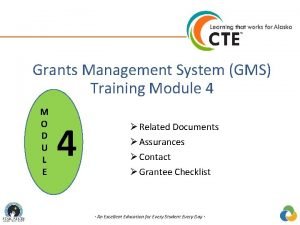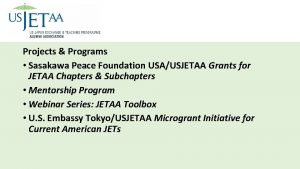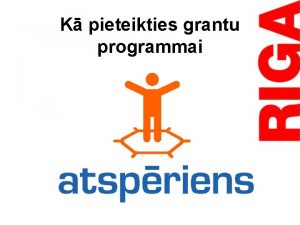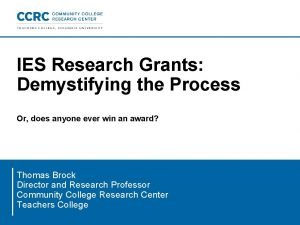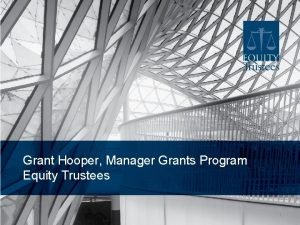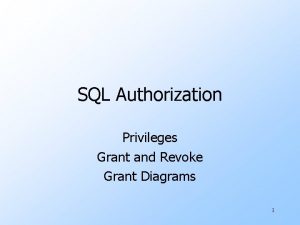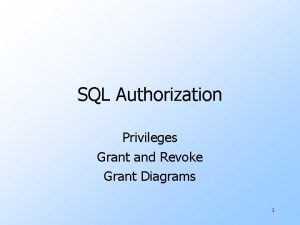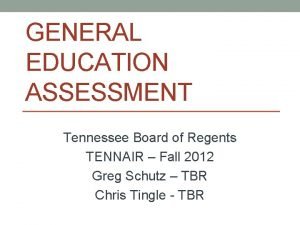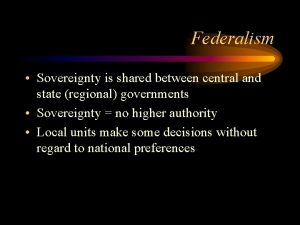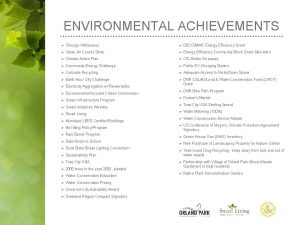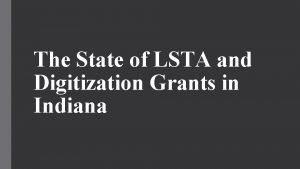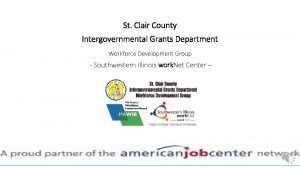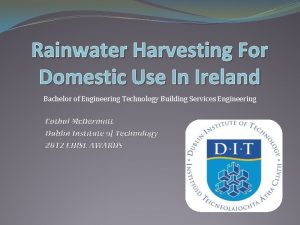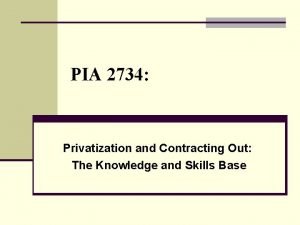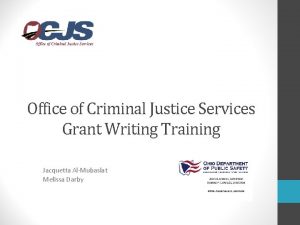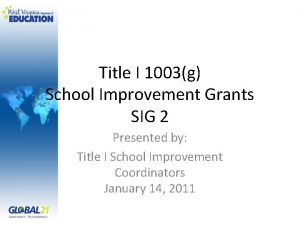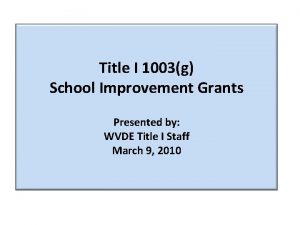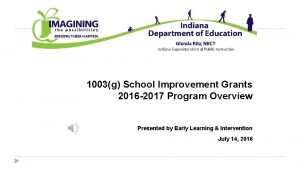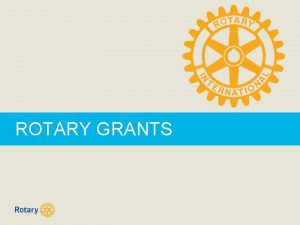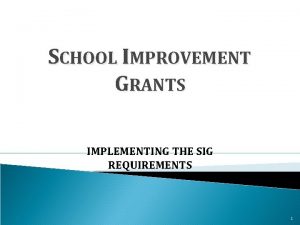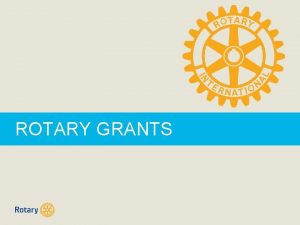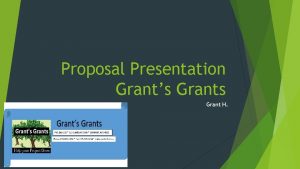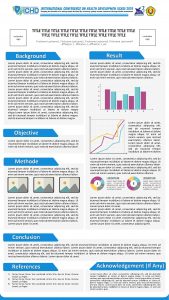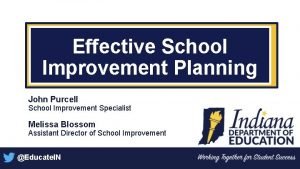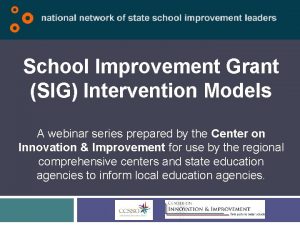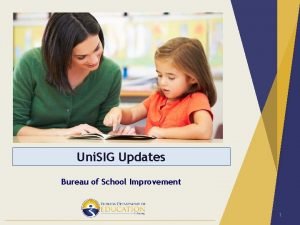Title I 1003g School Improvement Grants SIG 2































































- Slides: 63

Title I 1003(g) School Improvement Grants SIG 2 Presented by: Title I School Improvement Coordinators January 14, 2011

Title I 1003(g) School Improvement Grants 2 • Overview of SIG program • Identification of persistently lowest performing schools • SEA allocation of funds • Intervention models for Tier I and Tier II schools • SEA and LEA roles • Timeline • Reporting requirements • LEA letter of Intent to Apply • Questions and next steps 2

Overview of SIG Program • SIG 1 – Tier I = 4 schools received grants – Tier II = 11 schools received grants – Tier III = no schools received grants • LEAs applied on behalf of schools – Over $15 million was awarded • Required to carry over 25% • Carryover funds will be combined with EDFY 10 1003(g) funds for the SIG 2 3

Funding for SIG 2 • EDFY 10‐$3, 324, 544 • EDFY 09 carryover‐$5, 201, 304 • Districts will receive funding through a competitive grant process. • Priority for funding is given to Tier I and Tier II schools before Tier III schools may receive funds. 4

Identification of Schools When identifying the lowest achieving schools, the state must take into account both— • Academic achievement of the “all students” group in terms of proficiency in both reading/language arts and mathematics • Lack of progress on state assessments over several years in the “all” students” group 5

Identification of Schools Tier I schools - Any Title I school in improvement, corrective action, or restructuring that— • Is among the lowest‐achieving five percent of Title I schools in improvement, corrective action, or restructuring in the State or the five lowestachieving such schools (whichever number of schools is greater); or • Is a high school that has had a graduation rate as defined in 34 C. F. R. § 200. 19(b) that is below 60 percent over a number of years. Note: West Virginia identified the five lowest‐achieving of Title I schools in improvement, corrective action, or restructuring for Tier I. These are five different schools than those identified in SIG 1. 6

Identification of Schools Tier II schools ‐ Any secondary school that is eligible for, but does not receive, Title I, Part A funds that— • Is among the lowest‐achieving five percent of secondary schools or the five lowest‐achieving secondary schools in the State that are eligible for, but do not receive, Title I funds; or • Is a high school that has had a graduation rate as defined in 34 C. F. R. § 200. 19(b) that is below 60 percent over a number of years. Tier III schools ‐ Any Title I school in improvement, corrective action, or restructuring that is not a Tier I 7

Identification of SIG 2 Eligible Schools Tier III lowest performing 5 Title I schools identified for improvement Title I eligible secondary schools, but not receiving Title I funds remaining Title I schools identified for improvement which are currently not receiving SIG 1 funding Watts Elementary Welch Elementary Southside K‐ 8 Romney Elementary Spencer Primary Richwood High Cedar Grove Community Philippi Elementary Cherry River Elementary North Jefferson Keyser Primary/Middle Bluefield Intermediate Brookview Elementary Doddridge County Middle Clay Middle Mountain View Elem/Middle Van Devender Middle Pt. Pleasant Intermediate Petersburg Elementary

Purpose for the 1003(g) School Improvement Funds Provide funds to LEAs that: • Demonstrate the greatest need for funds • Demonstrate the strongest commitment to use the funds to turn around their persistently lowest achieving schools and raise student achievement in those schools 9

Goal for FY 10 1003(g) School Improvement Funds Target majority of funds to each state’s most persistently lowest achieving schools to significantly transform school culture and improve indicators of student success. 10

Questions 11

SEA Allocation of Funds • SEA must apportion school improvement funds to provide funding for three years – SY 11‐ 12 – SY 12‐ 13 – SY 13‐ 14 • LEA is eligible to apply for SIG funds if it – Receives Title I, Part A funds – Has one or more schools that are eligible to receive SIG funds as identified by the SEA 12

SEA Allocation of Funds • Competitive grants-SEA will prioritize school improvement grants to LEAs if sufficient school improvement funds are not available for all the schools for which the LEA applies to serve • $50, 000 to 2 million per year for each Tier I and Tier II school • $50, 000 minimum for Tier III schools 13

SEA Allocation of Funds • SEA must give priority to LEAs that apply to serve Tier I or Tier II schools • SEA may not award funds to any LEA for Tier III schools until the SEA has awarded funds to serve fully, all Tier I and Tier II schools that its LEAs commit to serve. • If an SEA has provided a SIG grant to each LEA that requested funds to serve a Tier I or Tier II school, the SEA may award remaining school improvement funds to LEAs that seek to serve Tier III schools. • Only an LEA that has no Tier I schools, may commit to serving only its Tier III schools 14

SEA Allocation of Funds The SEA will use the following to prioritize among Tier III schools: • Tier III schools selecting one of the four intervention models will be given first priority • The second priority will be given to schools further along in school improvement sanctions and they will be considered for higher levels of funding • Higher point total received on the LEA application 15

Questions 16

SIG Intervention Models Tier I and Tier II Schools School closure Turnaround Restart Transformation 17

School Closure Model • School closes and students are enrolled in another school in the LEA that is higher achieving – Schools should be within reasonable proximity to the closed school – Charter schools (not applicable for WV) – New schools for which achievement data is not yet available 18

School Closure Model West Virginia applicability • Policy 6204 gives the State Superintendent of Schools the power to declare that there is a need for an emergency school closure • This power has not been used aggressively in the past, but WV will consider using this authority if closing a school within a district is the most appropriate intervention for the students at the school and the community. 19

Turnaround Model • Replace the principal (July 2008) • Measure the effectiveness of staff who can work within the turnaround environment – Screen all existing staff and rehire no more than 50 percent – Select new staff for the other 50% • Implement strategies designed to recruit, place, and retain staff with the skills necessary to meet the needs of the students 20

Turnaround Model • Provide staff ongoing, high‐quality, job‐ embedded professional development • Adopt a new governance structure which may include – requiring the school to report to a new “turnaround office” in the LEA or SEA – hire a “turnaround leader” who reports directly to the Superintendent or Chief Academic Officer – enter into a multi‐year contract with the LEA or SEA to obtain added flexibility in exchange for greater accountability 21

Turnaround Model • Implement an instructional program that is vertically aligned from one grade to the next as well as aligned with State academic standards • Promote the continuous use of student data to inform and differentiate instruction (balanced assessment system) 22

Turnaround Model • Establish schedules and implement strategies that provide increased learning time as defined in the final regulations – minimum increase of 300 hours per year for core academic subjects – Longer school day, week, or year schedule • Provide appropriate social‐emotional and community‐oriented services and supports for students 23

Turnaround Model West Virginia Applicability • School closure and the turnaround intervention options are complicated by the rural nature of the state – More than half of all West Virginia schools are in rural areas – Approximately 40 percent of students statewide are from rural areas, more than double the national average of 19. 4 percent – 25 of the 55 districts in West Virginia support only one high school – School closure may not be a viable option, because students will not have another school to attend – Difficult to replace the principal and more than fifty percent of the staff in districts that are currently struggling to fill all of their teaching positions with highly qualified teachers 24

Restart Model • LEA converts a school or closes and reopens a school under a charter school operator, a charter management organization (CMO), or an education management organization (EMO) that has been selected through a rigorous review process – A rigorous review process could take such things into consideration as an applicant’s team, track record, instructional program, model’s theory of action, sustainability – SEA must review the process the LEA will use/has used to select the partner • A restart model must enroll, within the grades it serves, any former student who wishes to attend the school 25

Restart Model West Virginia Applicability This option is not currently available in WV because there is not a charter school law. If a charter school law is passed in the future, this may be an option for struggling schools in WV. 26

Transformation Model Under SIG’s transformation model, a school is required to implement all of the following four strategies: 1. Developing teacher and school leader effectiveness 2. Comprehensive instructional reform strategies 3. Extending learning time and creating community‐oriented schools 4. Providing operating flexibility and sustained support 27

Transformation Model Developing teacher and school leader effectiveness • Use rigorous, transparent and equitable evaluation systems that take into account data on student growth • Identify and reward school leaders, teachers, and other staff who have increased student achievement and the graduation rate 28

Transformation Model Developing teacher and school leader effectiveness • Replace the principal who led the school prior to commencement of the transformation model (Flexibility is granted if the principal was replaced no later than the start of the 2008‐ 2009 school year. ) • Provide relevant, ongoing, high‐quality job‐ embedded professional development • Implement strategies designed to recruit, place, and retain high‐quality staff 29

Transformation Model Comprehensive instructional reform strategies • Use data to identify and implement comprehensive, research‐based, instructional programs that are vertically aligned from one grade to the next as well as aligned with State academic standards • Promote the continuous use of student data to inform and differentiate instruction to meet students’ needs 30

Transformation Model Extending learning time and creating community-oriented schools • Provide more time for students to learn core academic content by expanding the school day, the school week, or the school year, and increasing instructional time for core academic subjects during the school day • Provide more time for teachers to collaborate • Provide more time for enrichment activities for students • Provide ongoing mechanisms for family and community engagement 31

Transformation Model Providing operating flexibility and sustained support • Give the school sufficient operating flexibility (including in staffing, calendars/time, and budgeting) to implement fully a comprehensive approach to substantially improve student achievement outcomes • Ensure that the school receives ongoing, intensive technical assistance and related support from the LEA, the SEA, or a designated external lead partner organization (such as a school turnaround organization or an EMO). 32

Transformation Model West Virginia Applicability This option is available in WV. LEAs having nine or more schools in Tier I and Tier II, may not implement this model in more than one half of the eligible schools. At this time, there are not more than nine low‐achieving Title I schools in any district in WV, so the federal restriction on the use of the transformation model does not apply. 33

Questions 34

Proposed Flexibility - Waivers • Section 421(b) of the General Education Provisions Act to extend the period of availability of SIG funds for the SEA and all of its LEAs to September 30, 2014 • Section 1116(b)(12) of the ESEA to permit LEAs to allow their Tier I schools that will implement a turnaround or restart model to “start over” in the school improvement timeline. 35

Proposed Reporting and Evaluation • For schools receiving SIG funds, SEAs will be required to report annual, school‐level data on outcome measures and leading indicators • ED is planning a multi‐year evaluation of SIG grantees to generate knowledge for the field and to help these schools improve their performance over time. 36

Proposed Reporting and Evaluation • For schools receiving SIG funds, SEAs will be required to report annual, school‐level data on outcome measures and leading indicators • ED is planning a multi‐year evaluation of SIG grantees to generate knowledge for the field and to help these schools improve their performance over time. 37

Proposed Reporting and Evaluation Leading Indicators for Which Schools Receiving SIG Funds will be Held Accountable • Number of instructional minutes within a school year • Student participation rate on State assessments in reading/language arts and mathematics by subgroup • Dropout rate • Student attendance rate • Teacher attendance rate • Number and percentage of students completing advanced coursework or dual enrollment classes • Discipline incidents • Truants • Distribution of teachers by performance level on an LEA’s teacher evaluation system 38

SEA Roles • Identify Tier I, Tier II and Tier III schools in the State • Write and submit the application to ED to receive the 1003(g) funds 39

SEA Roles • Establish criteria related to the overall quality of the LEA’s application and to the LEA’s capacity to implement fully and effectively the required interventions Must include the extent to which the LEA: – analyzed the needs of the school – matched an intervention to those needs – designed the interventions as part of a long‐term plan to sustain gains in student achievement – coordinated efforts with other resources – modified its practices, if necessary, to be able to implement the interventions fully and effectively 40

SEA Roles • Establish criteria related to the overall quality of the LEA’s application and to the LEA’s capacity to implement fully and effectively the required interventions (continued) – If an LEA lacks the capacity to implement one of the four interventions in each of its Tier I schools, the SEA would adjust the size of the LEA’s SIG grant accordingly. – Ensure that an LEA with nine or more eligible Tier I and Tier II schools does not implement the same model in more than 50% of those schools. 41

SEA Roles • Monitor the LEA’s implementation of interventions in and the progress of its participating schools • Hold each Tier I, Tier II and Tier III school accountable annually for meeting, or being on track to meet, the LEA’s student achievement goals 42

SEA Roles An SEA’s SIG grant award to an LEA must: • Include not less than $50, 000 or more than $2, 000 per year for each participating school • Provide sufficient SIG funds to meet, as closely as possible, the LEA’s budget request for each Tier I and Tier II school as well as for serving participating Tier III schools • Include requested funds for LEA‐level activities that support implementation of the school intervention models 43

SEA Roles An SEA’s SIG grant award to an LEA must: • Apportion FY 2010 SIG funds so as to provide funding to LEAs over three years if the SEA or LEA has requested a waiver to extend the period of availability. • An SEA that does not have sufficient SIG funds to allow each LEA with a Tier I or Tier II school to implement fully its selected intervention model may take into account the distribution of Tier I and Tier II schools among such LEAs in the State to ensure that Tier I and Tier II schools throughout the State can be served 44

LEA Roles LEA is required to: • Agree to serve each of its Tier I schools, unless the LEA demonstrates that it lacks sufficient capacity or sufficient funds • Submit a letter of intent to apply for the 1003(g) school improvement funds • Submit a competitive application to the SEA for the 1003(g) school improvement funds • Implement one of the four models in Tier I and Tier II schools it has the capacity to serve 45

LEA Roles LEA is required to: (continued) • Provide adequate resources to each Tier I and Tier II school it commits to serve in order to implement fully one of the four proposed interventions • Serve Tier I schools before it serves Tier III schools • Establish three‐year student achievement goals in reading/language arts and mathematics and hold each Tier I, Tier II and Tier III school accountable annually for meeting, or being on track to meet, those goals 46

WV Timeline Dec – Jan Identify schools Notify districts Provide overview to pertinent superintendents and Title I directors January 14, 2011 Jan - April Letter of intent to apply-due March 1, 2011 Technical assistance for writing the grant. March 10, 2011 LEAs write grantsdue to SEA on April 15, 2011 June - April - May SEA review of grant applications LEA presentation of grant applications September Award LEA grants Begin grant implementation in schools Onsite technical assistance from Title I school improvement coordinators 47

LUNCH BREAK 48

External Supporting Partners 49

Letter of Intent to Apply Due to SEA March 1 st • Identify schools the district intends to serve • Prepare a needs assessment for all schools the district intends to serve • Determine the LEA capacity based on the District Capacity Index • Submit a preliminary budget for 3 years for each school the district intends to serve 50

Identification of Schools • Identify schools the district intends to serve and the selected intervention model for each Tier I and Tier II school • Identify schools the district intends to serve and selected intervention strategies for each Tier III school 51

Needs Assessment 1. Analyze data – Overview of school AYP data – External trend data – Student achievement data – Other student outcome data – Analysis of culture, conditions and practices 2. Determine root causes – Administrators and teachers – Curriculum and materials – Master schedule, classroom schedules and classroom management/discipline – Students and parents 52

Capacity Index 53

Preliminary Budget • Estimate the amount of funds it will take to implement each of the steps of the turnaround model. • No cost associated with a particular step just put “ 0” 54

Pre-implementation Activities • Family and Community Engagement – Community meetings – Student and parent surveys • Instructional Programs – Summer school programs – Instructional materials • Professional Development and Support 55

Questions 56

Expectations for Schools Receiving 1003(g) SIG Funds • Select one of the four ED intervention models to fully implement (Tier I and Tier II schools) • Select a component or components of one of the intervention models on which to focus the school improvement efforts (Tier III schools) • Develop a focused, quality grant 57

Expectations for Schools Receiving 1003(g) SIG Funds • Replace the principal prior to the start of the 11‐ 12 school year (if a Tier I or Tier II school) • Become an “early adopter” of the revised educator performance evaluation that takes into account data on student growth • Organize the school staff into collaborative teams and provide high quality job‐ embedded professional development 58

Next Steps • Submit a letter of intent to apply by March 1, 2011 – Needs assessment and root causes – District capacity index – Preliminary Budget 59

Next Steps • Assemble a group of relevant stakeholders to provide input to the district team during the grant writing process • Share the needs assessment with the stakeholders and get input for selecting activities to address the root causes and deficiencies • Brainstorm activities and timelines to address the components of the intervention model that will be implemented for each Tier I and Tier II school • Brainstorm activities and timelines to address the specific section of one of the intervention models that will serve as the focus for Tier III schools will be addressed 60

Timelines November 30 ‐SEA submission of application to ED Early January ‐approval of application from ED January 14 ‐provide initial information on SIG 2 March 1 ‐Letter of Intent due to the Office of Title I March 10 ‐grant writing session for SIG 2 April 15 ‐SIG 2 grant applications due to Office of Title I • April 18 -29 ‐SEA review of SIG 2 applications • May 9 -13 ‐SIG 2 grant presentations to the SEA • June 1 ‐issue SIG 2 grants • • •

Final Thoughts Things I Understand Questions to be Clarified 62

SEA Contact Information Title I School Improvement Coordinators Suzette Cook scook@access. k 12. wv. us Karen Davies kdavies@access. k 12. wv. us Kenny Moles kmoles@access. k 12. wv. us Erin Sullivan esullivan@access. k 12. wv. us 63
 Nsf biological anthropology ddrig
Nsf biological anthropology ddrig Fha title i home improvement loan
Fha title i home improvement loan Prefatory part of report
Prefatory part of report Title title
Title title How to calculate annual attendance in shaala siddhi
How to calculate annual attendance in shaala siddhi Teacher subject improvement plan template
Teacher subject improvement plan template Strategic school improvement fund round 3
Strategic school improvement fund round 3 Data collection plan examples
Data collection plan examples School improvement plan michigan
School improvement plan michigan Strategic school improvement fund round 3
Strategic school improvement fund round 3 School improvement plan
School improvement plan School strengths and weaknesses list
School strengths and weaknesses list Ambition school leadership
Ambition school leadership Tdem grants management system
Tdem grants management system Ez fed grants login
Ez fed grants login Noaa grants online
Noaa grants online Grants ap gov
Grants ap gov Emd serono grants
Emd serono grants Grants portal uga
Grants portal uga Seta business funding
Seta business funding Grants ap gov
Grants ap gov Ezfed
Ezfed British academy small grant
British academy small grant Arts council national lottery project grants
Arts council national lottery project grants Ez fed grants
Ez fed grants Grants ap gov
Grants ap gov Iu grad grants
Iu grad grants New jersey grants & scholarships 2020-21
New jersey grants & scholarships 2020-21 Dep environmental education grants
Dep environmental education grants English nobility who received large land grants
English nobility who received large land grants Hrsa capital grants
Hrsa capital grants Ken emond british academy
Ken emond british academy Oracle state and local government
Oracle state and local government Grants management system gms
Grants management system gms Grants management system gms
Grants management system gms Usjetaa
Usjetaa Orphan products grants program
Orphan products grants program Noaa ago
Noaa ago Grants lick elementary
Grants lick elementary Kas ir granti
Kas ir granti Pcgo
Pcgo Ies research grants
Ies research grants Equity trustees grants
Equity trustees grants Lcif coordinator duties
Lcif coordinator duties Privilege diagram
Privilege diagram Sql authorization mechanism grants privileges on
Sql authorization mechanism grants privileges on Google grants workshop
Google grants workshop Competency assessment in tennessee
Competency assessment in tennessee Federal block grants
Federal block grants Creative federalism definition
Creative federalism definition Energy efficiency grants chicago
Energy efficiency grants chicago Digitization in indiana
Digitization in indiana Finnish cultural foundation grants
Finnish cultural foundation grants Allstate purple purse curriculum
Allstate purple purse curriculum Intergovernmental grants department
Intergovernmental grants department Uncc grants
Uncc grants Rainwater tanks ireland
Rainwater tanks ireland Nato pdd grants
Nato pdd grants Categorial grants
Categorial grants Ohio office of criminal justice services
Ohio office of criminal justice services Fp&m seta funding
Fp&m seta funding Fp&m seta login
Fp&m seta login Dorset growth hub grants
Dorset growth hub grants How did land grants and new roads affect brazil?
How did land grants and new roads affect brazil?
